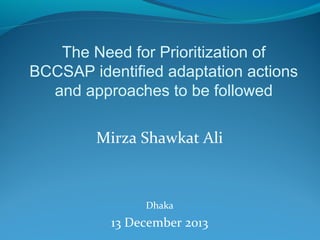The Need for Prioritization of BCCSAP identified adaptation actions and approaches to be followed �
- 1. The Need for Prioritization of BCCSAP identified adaptation actions and approaches to be followed Mirza Shawkat Ali Dhaka 13 December 2013
- 2. Outline ď‚—Why Prioritize ď‚—Approaches for Prioritization ď‚—Proposed Matrix for Prioritization
- 3. Why prioritize? ď‚—To optimize the utilization of limited resources ď‚—When the number of projects are high ď‚—Number of projects from a single sector are high; ď‚—BCCSAP has 44 programme areas and its difficult to implement all of them at the same time;
- 4. Project prioritization under NAPA Guidelines ď‚—NAPA used two tier approach to prioritize projects ď‚—Firstly, General Criteria used to select priority adaptation activities from a long list of potential activities (first order); ď‚—Level or degree of adverse effects of climate change; ď‚—Poverty reduction to enhance adaptive capacity; ď‚—Synergy with other multilateral environmental agreements ď‚—Cost effectiveness
- 5. Project prioritization and ranking ď‚—Secondly, used additional criteria for ranking; ď‚—Loss of live and livelihood ď‚—Human Health ď‚—Food Security and Agriculture ď‚—Water availability, quality and accessibility ď‚—Essential Infrastructure ď‚—Cultural Heritage ď‚—Biological diversity ď‚—Land-use management and Forestry ď‚—Other environmental amenities ď‚—Coastal zones, and associated loss of land
- 6. Other techniques to prioritize projects ď‚—Other techniques mentioned in NAPA; ď‚—Cost Benefit Analysis (CBA) ď‚—Cost Effectiveness Analysis (CEA) ď‚—Multi-criterial Analysis (MCA)
- 7. How we can proceed? ď‚—First, Set Sectoral Prioritization ď‚—Which Sector is most vulnerable ď‚— agriculture ď‚— water ď‚— coastal ď‚— health areas ď‚— ecosystems ď‚— infrastructure ď‚— Forest ď‚— Energy security ď‚—Which region is most vulnerable ď‚— Coastal zone ď‚— Flood prone areas ď‚— Drought prone areas
- 8. Priority Areas ď‚—Capacity building ď‚—legislation ď‚—Policies, plans and programmes ď‚—Early warning systems ď‚—natural disaster prevention
- 9. Tools and process for prioritization ď‚— Following criteria can be used to prioritize the projects ď‚— Relevance of the projects to Sectoral Priority ď‚— Development Goals of GOB/Sixth five year plan ď‚— Linkage with Thematic/Programme Areas of BCCSAP ď‚— Integration ď‚— Address climate change issues at local level ď‚— Address climate change at National level ď‚— Project Benefit ď‚— Social Benefits (poverty reduction/employment generation) ď‚— Environmental Benefits ď‚— Prioritized by consultation exercise. ď‚— Projects will be ranked based upon their respective scores, depending upon the availability of funds, the top ranked prioritized projects will be funded.
- 10. Criteria Relative importance/relevance Highly Very Relevant Slightly relevant relevant relevant 5 Relevance/Strategic Alignment •Sixth Five Year Plan •Sectoral Priority Strategic Alignment •with BCCSAP thematic areas Project Benefits •Social benefits (poverty reduction/employment) •Environmental benefits 4 3 2 Total Score Not relevant 1
- 11. Criteria Relative importance/relevance Highly Very Relevant Slightly Not relevant relevant relevant relevant 5 4 3 2 1 Sustainability of the project •Exit strategy of the project (how to sustain after the project completion) •Risk Analysis (whether the project is cost effective or not whether the project will be completed properly) •Cascading effect on similar sectors/projects •Address Climate Change issues at local level & enhance capacity of the local people Institutional capacity •Expertise to carry out the study •Logistical support Total Score












